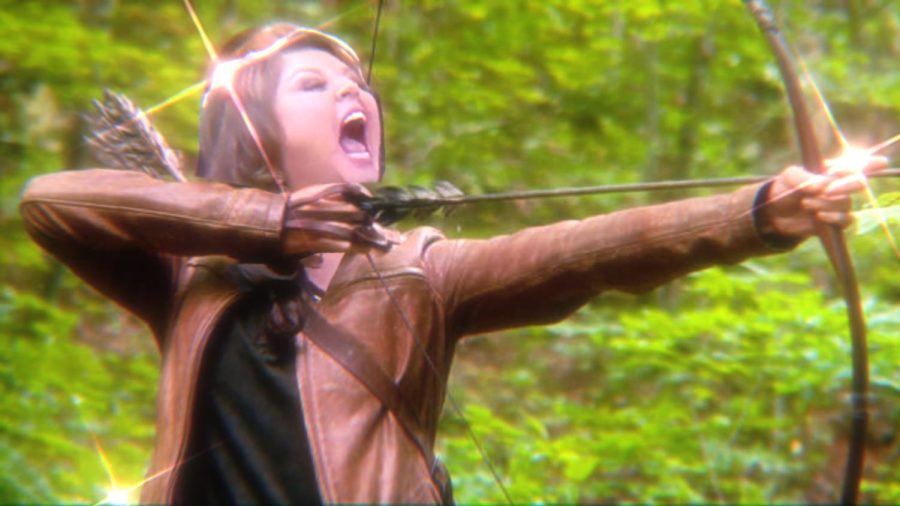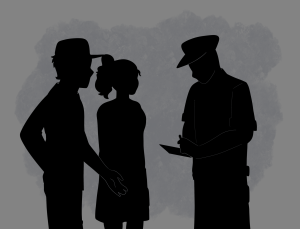Dance Moms: District 14
April 27, 2023
While in COVID-19 isolation, I spent my time binging the entirety of “Dance Moms” from start to finish, but before “Dance Moms,” I was fully absorbed in the “Hunger Games” resurgence that had been taking TikTok by storm.
“The Hunger Games” is a scathing critique of the way we sensationalize war in order to detach ourselves from the real violence of it. Underneath that, Collins also tackles the cultural phenomenon of reality TV, specifically the effects on child stars.
In “The Hunger Games,” Katniss and Peeta, two 16 year olds from the poorest area in Panem, a futuristic dictatorship in what was once the United States, are selected to fight to the death along with 22 other teenage “tributes” in the Hunger Games. This game will be broadcast on national television, and serves as a source of great entertainment for the Capitol, the wealthiest area in Panem. In order to win the games, they must get viewers to like them. If viewers like them, they will get sponsorship inside the arena – things like food, water and medicine. In the arena, Katniss and Peeta realize that by acting in love (kissing each other, caring for each other, etc.) they can get more sponsorships, therefore increasing their chances of making it out alive.
The Capitol audience can adore Katniss and Peeta’s relationship (ship name: Peeniss), they can feel heartbroken over the cruel irony of them fighting each other in these games and they can even get angry at the gamemakers for allowing bad things to happen to these tributes. I mean, of course they pity these two kids – they’re just kids – but in order for the audience to support these two star-crossed lovers against the odds, they must be complicit in the brutal torture and murder of 22 other children. For there to be tragic heroes in this game, by very definition, tragedy is required.
Now, let’s talk about “Dance Moms.” The title of the show says it all – we get to follow the lives of (originally) four mothers and their highly talented kids as they compete for the Abby Lee Dance Company at high profile tournaments across the country. We cheer as the kids win, we laugh as the mothers fight for their kids to have stage time and we get to watch some really great dancing.
Of course, because this show needs to be entertaining, it is full of fighting. In the series, there is an ongoing war between Abby as the owner of the studio and the dance moms themselves, with Abby often acting as the villain. When Abby screams at the young dancers, berates them and gets angry when they inevitably cry, the viewer obviously feels bad for these young girls. The biggest fabricated rivalry is the one between Maddie (who starts the show as an eight year old) and Chloe (who starts as a nine year old). In the competitions, Chloe never beats Maddie and almost consistently comes in second. This rivalry is only further exacerbated by the pyramid that Abby presents each episode of the girls’ headshots. Maddie is literally on top of Chloe in this pyramid from day one.
Now, I say this is a “fabricated” rivalry because it is entirely made up for the show. The editors don’t even do a very good job at hiding this – every clip we see of the girls interacting is kind and genuine. It’s so easy as a viewer to hate Maddie and her mother Melissa, because we see her as the villain to our sweet underdog, Chloe.
Of course, you could blame Abby for Maddie’s unfortunate villainization, but Abby is not in control of this show anymore than Caesar Flickerman was in charge of the Hunger Games. She is a pawn of the producers. Why are adult producers trying to make us hate an eight year old girl so much? Because we want to see it. Sure, we can say we’re morally superior because we’re on the “right” side in these fights, but that necessitates there being a fight in the first place. Children have to cry on national television and experience what likely was irreparable trauma (Chloe has stated in interviews since that she doesn’t remember anything from her time on the show, a common symptom of childhood trauma) for us to be satisfied feeling just bad enough for them.
I don’t say this from any kind of high horse. I already admitted to binging the entire show at the beginning of this article. That being said, if you watch the whole “Hunger Games” series back to back and then do the same thing with “Dance Moms,” you’re inevitably going to start making some unsavory comparisons. And yeah, the girls on “Dance Moms” don’t have to win or die, but Abby makes it very clear that losing is not an option – ”second is the first loser,” after all.
Perhaps the most concerning similarity is in the way these young children are often portrayed for adult audiences. Collins actually addresses the phenomenon of child star sexualization several times in her series: in the first book, a tribute named Glimmer wears a see-through dress for her interview with Caesar Flickerman, clearly because her designer thought it would garner her more (fully grown adult) sponsors. In the second book, former victor Finnick Odair, known for his dashing good looks (he won at only 14, mind you), heavily implies that he was prostituted out to wealthy Capitol citizens after his games.
In “Dance Moms,” the kids are usually wearing way less clothing than would be allowed under any elementary school dress code. Of course, competitive dance has its own cultural norms surrounding appropriate costuming, but ask yourself this question – why did the show have to be about kids’ dance? In one of the very first episodes of the very first season, Abby choreographs a dance to a song called “Electricity,” with incredibly raunchy dance moves. The girls are wearing what is essentially just shiny lingerie. Every single one of the dance moms protests this, saying it is wildly inappropriate for girls of only eight and nine. It would be so easy to call Abby the villain here, for making her students perform this number. The fact is, their moms let them perform the dance for national television, the producers gave the dance the go ahead and we all sat in front of our televisions and consumed it. How are we not complicit in this?
Somehow, three years after Collins’ groundbreaking book hit the market, Lifetime produced a real life “Hunger Games.” A lot of times when we consume dystopian literature, we have a tendency to think of it as illustrating a possible future. We debate in our ninth grade English classes if the circumstances in Orwell’s “1984” ever came to pass. The thing is, dystopian literature isn’t meant to be a prediction – it’s satire. “The Hunger Games” is satirizing the reality of the mid-2000s that Collins was living through. It’s not a crystal ball – it’s a mirror. So, no, you don’t have to stop watching “Dance Moms.” Maybe just feel a little bit more guilty about it. That’s my plan, anyways.
To read an extended version of Gillian Mackay-Brown’s opinion article, check out Birdbath publications.







